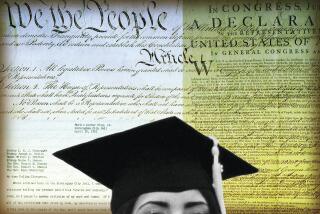Students would do well to learn cursive, advocate says
- Share via
Before students hunker down to take their SATs this spring, many will have an array of tools to help them with the exam.
Flash cards, study guides and — cursive handwriting?
For many, cursive handwriting is a thing of the past, an archaic method taught in the days before keyboards and touch screens. But some argue that writing longhand could help in placement exams.
National core standards don’t require cursive to be taught to students, but some states, including California, Alabama and Georgia, have included cursive handwriting in their state requirements in early elementary grades, something supporters say should be more widespread.
“Cursive is about connections, not the slant. It’s not calligraphy. It’s functional,” said Suzanne Asherson, a national presenter for Handwriting Without Tears, a handwriting program for teachers. “Cursive is faster and more efficient than print. When a child knows the mechanics of forming letters in cursive, they can better focus on their content.”
Asherson argues that the swirled letters and connected tails are beneficial to students even beyond the third- and fourth-grade state standard and well into high school. She recently led a workshop in North Hollywood for elementary school teachers instructing them on the basics of teaching cursive.
“If you’re only going to teach it in third grade, then there is validity to the question ‘Why learn cursive?’” said Sophie Jacks, a third-grade teacher at NEW Academy Canoga Park charter school who attended Asherson’s workshop.
“If you only teach them to write the letters, then it’s only a craft they’ve learned and not a practice. It’s something that should be a part of our students’ continuing education.”
Handwriting Without Tears endorses a simplified method, “without the curly q’s and loopty loops,” Asherson said. Without the extra flair, children are able to focus on what they’re writing instead of how they form the letters.
Jacks and Asherson cited a study conducted by the College Board a year after implementing a handwritten portion to the SAT in which the student essay responses were coded across a variety of characteristics such as number of paragraphs, words and whether they were written in first person. The essays also were coded as print or cursive.
The study — based on 6,498 randomly sampled tests administered between March 2005 and January 2006 — revealed that 15% of the essays were written in cursive and received a slightly higher sub-score than printed essays.
“It’s easier to read and easier to score,” Asherson said.
Still, the study is not enough to convince Morgan Polikoff, an assistant professor at USC Rossier School of Education.
The percentage of essays written in cursive “is not evidence of anything,” he said. “It doesn’t indicate that the knowledge of cursive causes higher scores, but it might suggest that the kind of folks who write in cursive during SATs do so because they’re probably smarter.”
Polikoff researches the design and effects of standards-based reform, including the Common Core, and doesn’t expect many states to include long form in their curricula. In 2011, Hawaii and Indiana dropped the requirement from their course of study in favor of keyboard proficiency.
“The simple fact is that cursive is not included in the common core,” he said, and added that though states are able to choose up to 15% of the standards, few decide to add cursive.
“I think it’s important to have nice handwriting, but the importance of having to learn two kinds of handwriting seems unnecessary given the vast method of communication is on a keyboard,” Polikoff said. “One reason [to teach it] might be to be able to read historical documents and old journals that are written in cursive.”
dalina.castellanos@latimes.com
More to Read
Sign up for Essential California
The most important California stories and recommendations in your inbox every morning.
You may occasionally receive promotional content from the Los Angeles Times.










